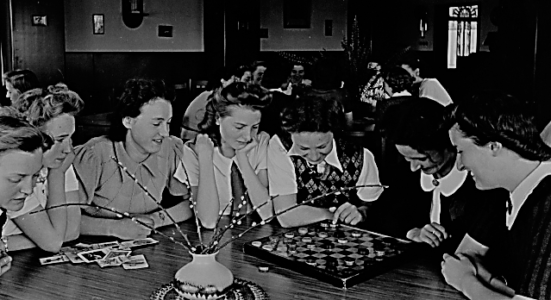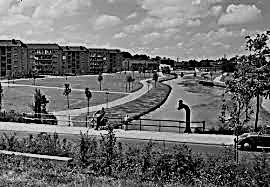
Fishing
Written by Bert Plomp
Summer and winter, from early morning until sunset, I could be found on the street, with a short break for meals and school visits. I wanted to play indoors as well, but there was no room for that. Besides, there was little to nothing to do indoors. After all, my friends were all outside. If I did stay indoors, I was often kicked out of the house because my parents wanted peace and quiet.
To play indoors with some friends, you needed space. In the Napoleon Square, few houses were suitable for this. The neighborhood consisted mostly of apartment buildings, with flats containing three to four rooms. Having fun in such a flat usually meant that, under the watchful eye of the lady of the house, you could play a small game on the living room floor. Games from the ‘Toon Hermans Sinterklaas assortment,’ such as ‘Fishing,’ ‘Hat Toss,’ and ‘Sorry!’. Fishing, in particular, was one of the most mind-numbing games a child could be exposed to in those days. In this so-called sport, every participating child was equipped with a tiny fishing rod. That fishing rod was nothing more than a short bamboo stick with a nylon line attached to the tip. At the end of the line dangled an extremely weak, horseshoe-shaped magnet. Armed with such a pitiful fishing rod, you had to sit in a kind of cardboard aquarium along with other children and fish. You were fishing for a number of cardboard fish located at the bottom of the aquarium. These fish were also made of cardboard and had an iron ring through their nose. The magnet came in handy to catch a fish. So, the aquarium was nothing more than an upright, cardboard cube. It had no bottom and no lid. The sides were subtly decorated with images of fish. The competitive element was about catching as many fish as possible. It was very irritating when you thought you had a catch, only to see the ringed creature fall back to the bottom halfway along the edge of the aquarium. This happened purely because the magnet no longer attracted it.
So, I preferred to go fishing outside in the fresh air. The river Kromme Rijn offered more than enough opportunities in that regard. In the summer, we swam in the Kromme Rijn, and in the winter, we skated on it. However, you had to be very cautious with ice skating because the river was regularly dammed. Before you knew it, the ice was under water, and the ice sheet was in motion. The days when we could skate were fantastic. After a night of snowfall, everyone went out with wooden snow shovels to prepare a smooth track. The Prinsenbrug and the viaduct near Galgenwaard also tempted us to take risks. Who dares to skate further than me on the ever-thinning ice? It was quite a challenge. If you fell through the ice, you were immediately in mortal danger. Under the ice, you could be swept away by the current and possibly resurface at the Tolsteegsingel or in one of the canals.
Even then, the river’s water was polluted. Perhaps even more so than now. It was teeming with rats. When we went swimming in the summer, not only did the threat of Leptospirosis loom, but there was also dangerous waste on the bottom. Old, discarded bicycles, mopeds, prams, car parts, and other iron junk. You could seriously injure yourself on those old, rusty remains. Nonetheless, we jumped into the water from the Prinsenbrug without a care in the world. Every now and then, we even had the courage to dive off the bridge into that underwater junkyard. Especially near the bridge, most discarded items were waiting on the bottom for daredevils. In the park, the story went around that one evening in the fall, a shady character tried to secretly throw an old stove over the bridge railing into the water, and he disappeared into the water with the stove. He never surfaced again, not even near Ledig Erf. Apparently, he was so attached to his old, faithful companion that had provided him with so much warmth selflessly that he couldn’t let go.
Although the water of the Kromme Rijn was considered treacherous at the time, people still fished there. Occasionally, the fish were simply there for the taking. The water surface was covered with dead fish on ‘dirty’ days. Fish with their white bellies up, forming a true shroud on the river. It meant that something nasty had been dumped further upstream in the Kromme Rijn. On ‘healthy’ days, we tried to catch a fish with a simple fishing rod. However, this rarely worked. That’s why we mostly used a fine-meshed net to catch sticklebacks. At home, swimming in a glass jam jar, those little creatures didn’t last much longer than a few days. That was the end of the fun.
TO BE CONTINUED
For all episodes, click on: Simple pleasures
For more free stories join my Facebook page:

